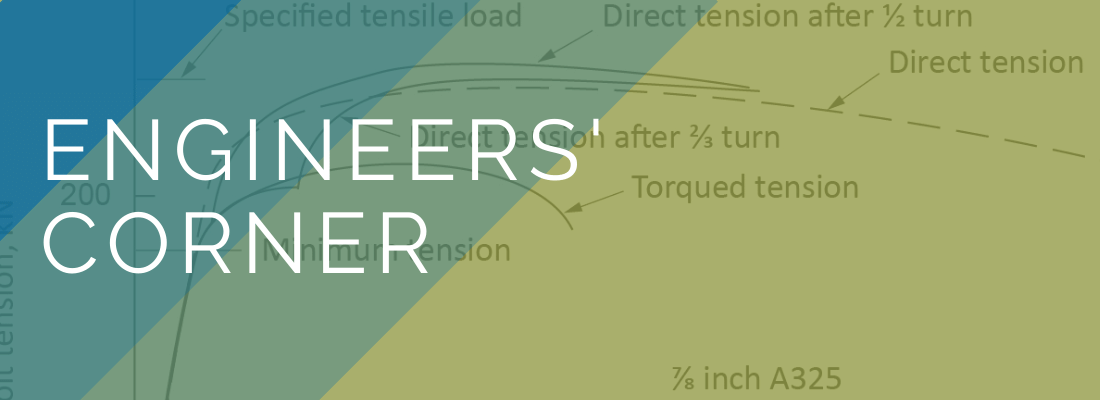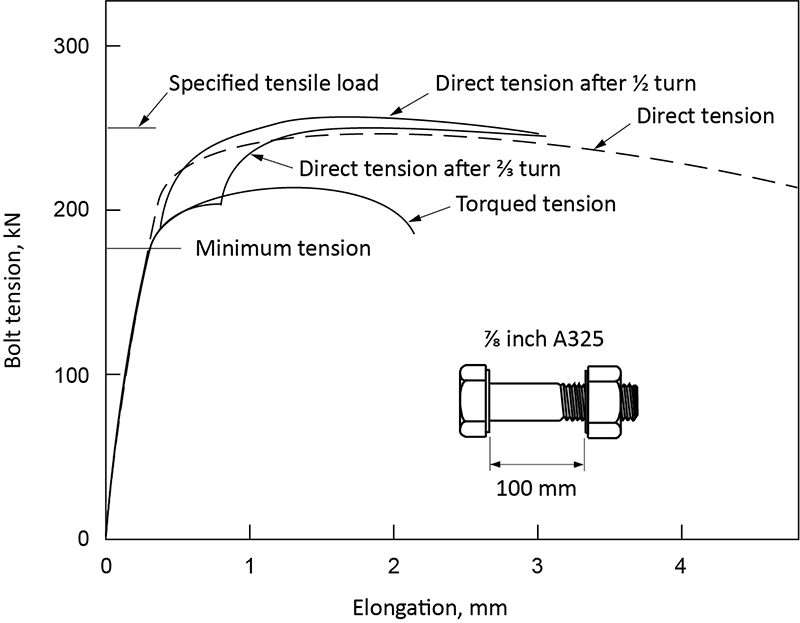
The turn-of-nut method is the standard installation method for high-strength fasteners such as ASTM F3125 grade A325 and A490 bolts.
Pretensioned assemblies are installed to a minimum bolt tension specified in CSA S16-14 Table 7. According to Table 8, for a bolt length between 4 and 8 diameters (not exceeding 200 mm) for example, the nut must be rotated ½ turn from the snug-tight condition.
Engineers sometimes wonder about the possible detrimental effects of over-tightening. Specifically, is there a concern if the tension in Table 7 is exceeded?
To answer the question, consider the behaviour of a ⅞ inch A325 bolt pretensioned by tightening the nut (torqued tension) and subsequently loaded in direct tension, as shown in Figure 1. The figure illustrates the reserve tensile strength after bolt installation and contains four curves:
- Torqued tension
- Direct tension (dashed curve)
- Direct tension after ½ turn
- Direct tension after ⅔ turn

Figure 1
Reserve Tensile Strength After Bolt Installation
Curve no. 3 shows a high-strength bolt subjected to a ½ turn rotation, and then loaded in direct tension. If another bolt is subjected instead to a greater rotation (e.g., ⅔ turn along curve no. 4), both bolts will end up essentially on the same “direct tension” dashed curve. This is because the load-deformation curve is relatively flat in the inelastic region. Any variation in the snug-tight condition will result in only minor variations in bolt pretension.
According to Kulak et al (1987): “Loading a bolt in direct tension after having preloaded it by tightening the nut (torqued tension) does not significantly decrease the ultimate tensile strength of the bolt … The torsional stresses induced by torquing the bolt apparently have a negligible effect on the tensile strength of the bolt. This means that bolts installed by torquing can sustain direct tension loads without any apparent reduction in their ultimate tensile strength.”
S16-14 Clause 23.8.2 states: “Bolt tensions exceeding those specified in Table 7 shall not be cause for rejection.” In summary, as long as the bolt has not broken off during installation, over-tightening is not a concern.
References:
AISC. Modern Steel Construction. 2010. Steel Quiz. American Institute of Steel Construction. February.
Kulak, G.L., Fisher, J.W., and Struik, J.H.A. 1987. Guide to Design Criteria for Bolted and Riveted Joints, 2nd Edition. John Wiley and Sons. pp. 41 and 56.








